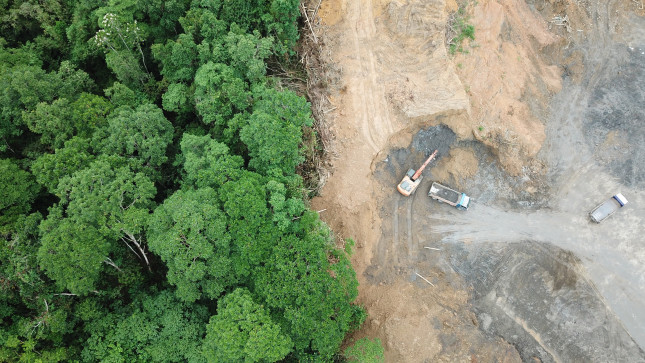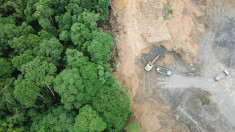-
To Envision a More Sustainable Future Tell the Story of Conservation Technology
February 12, 2020 By Lisa Palmer Last summer, I stood on a cliff 100 feet above the Madre De Dios River, in Southern Peru near the Bolivian border, to watch the rosy gift of an Amazon sunset. It was quiet, in a tropical rainforest way, with the light clamor of parrots, macaws, and cicadas. Then, a peke-peke motorized canoe broke through the soft din. It arrived from the east, carrying a new supply of diesel fuel for the gold miners who were prepping the generator that would operate a suction-pump and dredge for gold across the river and around the bend. Before nightfall, the fuel ignited the baritone of a diesel generator. It moaned all night and all day, barely stopping. In subsequent days, instead of a light clamor of birds and primates, the thrum of a gold mining operation seemed like all I could hear.
Last summer, I stood on a cliff 100 feet above the Madre De Dios River, in Southern Peru near the Bolivian border, to watch the rosy gift of an Amazon sunset. It was quiet, in a tropical rainforest way, with the light clamor of parrots, macaws, and cicadas. Then, a peke-peke motorized canoe broke through the soft din. It arrived from the east, carrying a new supply of diesel fuel for the gold miners who were prepping the generator that would operate a suction-pump and dredge for gold across the river and around the bend. Before nightfall, the fuel ignited the baritone of a diesel generator. It moaned all night and all day, barely stopping. In subsequent days, instead of a light clamor of birds and primates, the thrum of a gold mining operation seemed like all I could hear.
Last summer, I stood on a cliff 100 feet above the Madre De Dios River, in Southern Peru near the Bolivian border, to watch the rosy gift of an Amazon sunset. It was quiet, in a tropical rainforest way, with the light clamor of parrots, macaws, and cicadas. Then, a peke-peke motorized canoe broke through the soft din. It arrived from the east, carrying a new supply of diesel fuel for the gold miners who were prepping the generator that would operate a suction-pump and dredge for gold across the river and around the bend. Before nightfall, the fuel ignited the baritone of a diesel generator. It moaned all night and all day, barely stopping. In subsequent days, instead of a light clamor of birds and primates, the thrum of a gold mining operation seemed like all I could hear.
In my 10 days at the Los Amigos Biological Station, a chorus of sounds became a constant reminder that Peru’s tropical forests are being destroyed. Whirring drones operated by conservation technologists surveilled the forest for its biodiversity and for its illegal loggers. River patrols by the promotores of the Amazon Conservation – ACCA in Peru clanked along in motored canoes. I published my insights from this trip to the Peruvian Amazon in Mongabay, a non-profit conservation and environmental science news organization. While the Los Amigos Biological Station is actively protected, enforcement of strict mining laws has failed elsewhere. Policing remote areas has been futile. Attempts to change the mining industry or prevent illegal logging have not worked. It is clear that the forests of Peru are in trouble. While national policies are strong, local governance is weak or nonexistent.
At Los Amigos I had joined a group of technologists who were looking to the power of tech to guard against illegal gold miners and illegal loggers. They sought to scale up efforts that use drones, acoustic monitoring, machine learning, LIDAR, and thermal imaging to protect the world’s most remote and biologically diverse regions. Their efforts couldn’t come soon enough. By late summer, fires and deforestation threatened vast stretches of Brazil, dwarfing anything that I observed in Peru or Colombia, a month earlier.
My time at Los Amigos made it more clear to me that technological approaches to conservation—including data collection—combined with stronger governance is one of the best chances we have to work towards a sustainable future.
To encourage this ground-breaking work, we need to better tell its story. The battle for a sustainable future is taking place in remote places, and there is a growing need to send journalists, photographers, and filmmakers to capture the sounds—and stories—of conservation technology and how it’s being applied. We need to better understand and respond to the lack of economic opportunities for rural people. We need to hold governments, businesses, and individuals accountable for wrongdoing and neglect.
As journalists, we must broaden our skills in science and environmental storytelling, to simultaneously include socio-cultural values, financial and legal systems, spirituality, traditional knowledge, and economics, so we can tell the complete story. Science and environmental journalists must be able to accurately explain the importance of developments in science and environmental change to ensure the public has the information it needs to make well informed decisions on how to interact with and respond to scientific innovations.
Through the Sustainable Development Goals, the Paris Agreement, and other agreements, the world has on paper agreed to not let the trends of widening inequality, increasing pressure on natural resources, and threats to our environment run rampant. It’s time we use broader communication skills to capture and share a complete picture of the problem and solutions. Storytelling needs to not only tell a holistic picture of the world to inform decision-making, but also help the world envision what a sustainable future could look like. Otherwise, what are we working toward?
Lisa Palmer is the inaugural National Geographic Visiting Professor of Science Communication at the School of Media and Public Affairs at George Washington University. She is also a Senior Fellow at the National Socio-Environmental Synthesis Center. A former Wilson Center Fellow, she is the author of HOT, HUNGRY PLANET: The Fight to Stop a Global Food Crisis in the Face of Climate Change (St. Martin’s Press; 2017).
Photo Credit: Photo via Shutterstock. All rights reserved.
 A Publication of the Stimson Center.
A Publication of the Stimson Center.

 Last summer, I stood on a cliff 100 feet above the Madre De Dios River, in Southern Peru near the Bolivian border, to watch the rosy gift of an Amazon sunset. It was quiet, in a tropical rainforest way, with the light clamor of parrots, macaws, and cicadas. Then, a peke-peke motorized canoe broke through the soft din. It arrived from the east, carrying a new supply of diesel fuel for the gold miners who were prepping the generator that would operate a suction-pump and dredge for gold across the river and around the bend. Before nightfall, the fuel ignited the baritone of a diesel generator. It moaned all night and all day, barely stopping. In subsequent days, instead of a light clamor of birds and primates, the thrum of a gold mining operation seemed like all I could hear.
Last summer, I stood on a cliff 100 feet above the Madre De Dios River, in Southern Peru near the Bolivian border, to watch the rosy gift of an Amazon sunset. It was quiet, in a tropical rainforest way, with the light clamor of parrots, macaws, and cicadas. Then, a peke-peke motorized canoe broke through the soft din. It arrived from the east, carrying a new supply of diesel fuel for the gold miners who were prepping the generator that would operate a suction-pump and dredge for gold across the river and around the bend. Before nightfall, the fuel ignited the baritone of a diesel generator. It moaned all night and all day, barely stopping. In subsequent days, instead of a light clamor of birds and primates, the thrum of a gold mining operation seemed like all I could hear.

